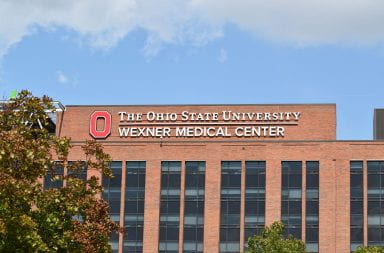Since the South Drive-in movie theater parked in Columbus in 1950, more than 150 Ohio drive-ins have closed. A vehicle for making out and movie watching through 12 presidents and 59 Clint Eastwood movies, the only drive-in left in town turns 60 this month.
But Sunday night’s rain steered all but four cars clear of the South Drive-in’s lot. The action from “The Losers” interrupted by windshield wipers was a microcosm of why the drive-in industry has had so many losers of its own.
The South Drive-in uses a special long-distance picturing projector to drive film images through rain, said general manager Bryon Teagardner. The 4,000-watt bulbs emit a picture more than 100 feet onto the screens.
Though these projectors produce perfect picture quality on the screens in the rain, windshield wipers put the brakes on the experience.
Many types of weather, for that matter, hurt drive-in theaters. Too much heat in the summer indirectly increases the price of viewing because drivers must run their air-conditioning. Too little heat in the winter is even worse.
“People won’t come out in the winter to sit in their car and waste gas to watch movies,” Teagardner said.
There was a time when the South Drive-in stepped on the gas to outpace Old Man Winter by putting heaters on the speaker-poles for each car. But it was not cost-effective to stay open in the winter.
The one element that junked most drive-ins and redlined the indoor industry was light. Indoor theaters can block out light easily, while drive-ins can only show movies at night when the sun sets.
There is only so much time from sunset to sunrise, Teagardner said.
And there is even less darkness in the warmer months, when drive-ins are open.
A tall treeline that cuts off surrounding city and street lights from the screens has helped keep the South Drive-in from stalling. But other drive-ins yielded to indoor theaters with dark rooms and all-day show times.
Ohio’s drive-in industry peaked in 1958 with 196 open theaters, according to drive-ins.com. It remained steady throughout the 1960s, and there were still 181 drive-ins open in 1972.
But as more indoor theaters were built, more drive-ins closed until there were 157 open in 1979. The needle moved more toward empty through the first four years of the 1980s, when more than 600 drive-ins closed nationally.
Another contributing factor to this decline was that drive-ins had to compete with indoor theaters for first-run movies, Teagardner said.
Theaters must pay movie studios a percentage of box office sales for that studio’s movie. By denying drive-ins new movies, the studios made people wanting to see them go indoors.
By 2000, there were just 43 drive-ins left in Ohio. And the fewer there were, the more expensive it became to service or replace long-distance picturing equipment for the others, Teagardner said.
But despite such road blocks and because of its prime real estate on South High Street, the South Drive-in’s odometer is still rolling.
It first turned the key on May 11, 1950, by showing “Down Dakota Way,” a Roy Rogers Western, and “Francis,” a comedy about a talking mule, on its one screen. That screen was destroyed by a tornado and rebuilt in 1973.
The South Drive-in used to charge admission per carload, but after a jump-start from its second screen in 1980, it began charging per person to better compete with indoor theaters.
Today, it takes 15 people for the theater to run a show, and it is using new techniques to battle indoor cinemas. The drive-in’s Facebook page, for example, gained 98 friends in the last two days, Teagardner said.
Last year, the South Drive-in even had a show sell out. Cars filled all 476 of screen one’s spaces for “Transformers 2.”
On May 14, the drive-in will celebrate its 60th anniversary; but there are still issues threatening it and other drive-in theaters.
One is the digital conversion. Every theater in the country belongs to the Motion Picture Association of America, which began producing
digital movies last year.
“It’s cheaper for them to ship a CD than 50 pounds of film,” Teagardner said. “It would cost us $250,000 per screen to switch to digital.”
But until more theaters accommodate this technology, studios will continue to print movies on film. This is good news for the South Drive-in and others like it that can’t afford such an oil change.
More good news is that to preserve the outgoing fashion of drive-in theaters, studios reversed the aforementioned trend and now assist what few drive-ins are left with first-run movies, Teagardner said.
The South Drive-in is showing the new “Nightmare on Elm Street” and “The Crazies” on screen one and “The Losers” and “Clash of the Titans” on screen two.
But to remain qualified for these new releases, the drive-in needs to be open seven days a week for at least part of the year. Movies now show on Friday, Saturday and Sunday nights only. But for the next three weeks, they will show every night, Teagardner said.
At 3050 S. High St., the South Drive-in opened April 16 this year and will stay open until mid-November. It has a 750-car capacity spread over two lots that share a full-service concession stand.
The venue allows dogs, motorcycles and grills, as well as the other standard drive-in-theater benefits such as adjustable reclining and privacy.
“It’s not against our policy to bring alcohol in as long as it’s in a different container,” Teagardner said.
Viewers get to see two movies split by an intermission for $8. On Fridays and Saturdays, the first showing is repeated after midnight, giving viewers three films for the price of one.
The rain stopped Sunday night during intermission. “Clash of the Titans” glowed brilliantly on the screen against the night sky as its surround sound boomed through the car’s FM radio. And the South Drive-in continues to roll on.


